Achieving success while remaining resilient and healthy can be difficult. An important step to creating personal and professional excellence is developing the ability to generate more coherence — the highly ordered state in which your body’s systems are synchronized for maximum efficiency. Coherence is a state of calm, focus, heightened awareness and balance. When in a high state of coherence you are operating at peak performance. Decision-making, communication skills, relationships, mental clarity, and leadership effectiveness are all enhanced.
The emWave System provides a window through which you can observe and measure your coherence — the physiological state that supports peak performance and good health.
Coherence is a progressive state: the more we build it, the more we have in reserve. The aim of using the emWave System is to increase the ratio of time spent in coherence. Increased personal coherence yields greater flexibility, productivity, creativity and less stress.
Getting Started
Under the appropriate emWave Tour, detailed information about the emWave system’s features and functions. Start here to get clear instructions on how to use this program. Next, learn review the Quick Coherence® Technique. Click here to learn what coherence is and get step by step instructions on how to build coherence with the Quick Coherence technique.
With practice, once you’ve learned how to record a session while using the Quick Coherence technique, you’ll start to see the heart rhythm pattern change. When you shift to and sustain a positive emotion, the beat-to-beat changes in your heart rate will create a smooth pattern and your coherence score will increase. You can train with the Coherence Coach® to fine tune your coherence-building skills. The Coherence Coach can be found in the View menu within the program.
Once you are able to achieve 50% or more medium or high coherence, you are ready to add another entertaining way to practice your skills with one of the emWave games or the Emotion Visualizer® sessions. The games and Emotion Visualizers can be found in the View menu.
It is recommended that you do 5 to 15 minute sessions on the emWave System, five days a week. Of course you can do longer or more frequent sessions if you’d like, or if situations are particularly challenging or stressful. With practice you will increase your coherence scores. This is evidence that you are retraining your system so that you have a new internal baseline that is more naturally coherent.
Suggested Applications
- In the morning before you start your work day to set a baseline for increased clarity and performance
- Take a five-minute break during the day to recharge your system.
- After a particularly stressful experience to bring you back to balance mentally, emotionally and physically.
- Before a meeting to increase your mental acuity and emotional balance.
- Before and during creative projects to give your system a boost.
- While traveling — at the airport, on the plane, in your hotel — to maintain balance and stay energized.
- Before going to bed to facilitate deeper, more regenerative sleep. Bringing your system into coherence can help you sleep more deeply and wake up refreshed.
“Thank you for the excellent contribution the HeartMath program has made to the Stanford Executive Program over the past seven years. I have seen that the HeartMath tools provide our executive participants with very important and highly relevant skills for managing large, complicated organizations anywhere in the world, and for managing oneself. In this increasingly competitive global environment, the skills you have taught these leaders provide them with both the confidence and the strategies to transition back to their environments with a minimal level of stress and an optimal level of effectiveness.”
— Beverly H. Smith, Administrative Director, Stanford Executive Program
“This is a great set of leadership tools. I can now recognize and deal with stress as it comes. I find myself much more aware of when I have become angry or frustrated… I recognize and use the tools to restore balance and a more positive attitude. Another benefit of using HeartMath is I don’t wake up tired anymore. I plan better, and am able to be more direct with people.”
— Sam Ruffing, MS, RN, Vice President, Methodist Health System
Enjoy using your emWave System and experience the benefits of coherence for your mind, body and heart.
Corporate: Results
HeartMath training programs are delivered through dozens of organizations around the world each year. Each program includes instruction on the use of emWave® systems to improve personal and organizational performance. Numerous research studies have shown the HeartMath process and coherence-building technology to be highly effective in improving the well-being and performance of employees and executives in the workplace environment. To view more research studies, please visit the HeartMath Web site at:
https://www.heartmath.com/organizations/
“An effective tool for me to deal with stress and to increase my productivity, clarity of thinking, intuitive listening and energy… What better time than now?”
— Fortune 500 Vice President, Environment, Health and Safety
Coherence Improves Cognitive Performance
Good decision making, strategic thinking, innovation and communication effectiveness are all underpinned by emotional stability and efficient cognitive processes. A number of studies have shown increased heart rhythm coherence significantly improves various aspects of cognitive functions and performance. In this section we summarize several studies demonstrating how coherence can improve discrimination and memory. Studies showing that these improvements translate to practical applications are illustrated in the data studies conducted with law enforcement agencies, corporations and hospitals. Additional examples are summaries in the learning and test-taking section that show significantly improved academic performance.
Coherence and Improved Motor Skills, Focused Attention and Discrimination
In this investigation, 30 participants – 13 males and 17 females ranging from ages 26 to 52, with a mean age of 44, – previously screened for their ability to maintain psychophysiological coherence were randomly divided into matched control and experimental groups based on age and gender. To assess cognitive performance, we measured participants’ reaction times in an auditory discrimination task that requires focus and attention, accurate discrimination and quick and accurate reactions before and after maintaining the coherent state for 10 minutes. In this test, subjects listened through headphones to a series of two similar tones that were randomly presented around two seconds apart. Participants pressed a button as quickly as possible when they heard one of the tones. The interval between the presentation of a tone and the pressing of the button is the reaction time. Following a 10-minute baseline period, participants performed the first of two 10-minute auditory discrimination tasks. Then the experimental group members were asked to use the Heart Lock-In® emotional restructuring technique for 10 minutes, while those in the control group were instructed to relax for 10 minutes without adopting a specific mental or emotional focus. Immediately following this, all participants performed a second 10-minute auditory discrimination task, the results of which were compared to the first. This enabled us to determine if changes occurred in cognitive performance in either of the two groups and if heart rhythm coherence was related to cognitive performance.
First, we found there was a significant increase in heart rhythm coherence (p < 0.05) in the experimental group who used the Heart Lock-In technique, but not in the relaxation control group. Furthermore, the experimental group demonstrated a mean decrease of 37 milliseconds in their reaction times – corresponding to a significant (p < 0.05) improvement in cognitive performance – whereas the control group showed no change. In addition, there was a significant relationship (r² = 0.21; p = 0.015) between the degree of heart rhythm coherence and performance (reaction time) across all subjects and conditions: Increased coherence was associated with decreased reaction times (improved performance).
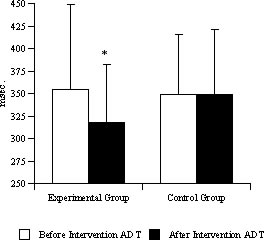
Reaction time changes. Mean reaction times for the experimental versus control group during the first (pre-intervention) and second (post-intervention) auditory discrimination tasks (ADT). The experimental group, who maintained the psychophysiological coherence mode prior to the second ADT, demonstrated a significant reduction in mean reaction time, indicative of improved cognitive performance. In contrast, control group participants, who engaged in an open-focus relaxation period during the interval between tests, showed virtually no change in mean reaction time from the first to the second discrimination task. *p < 0.05.
This experiment demonstrated that cognitive performance can be improved by maintaining psychophysiological coherence prior to performing a task and that there appears to be a carryover effect of the coherence mode on subsequent cognitive performance. Importantly, these findings suggest a physiological link between positive emotions and improvements in faculties such as motor skills, focused attention and discrimination. More broadly, these results provide evidence that the overall organization of the heart’s rhythmic activity, and thus the pattern of cardiac afferent (ascending) input to the brain, can significantly inhibit or facilitate cortical function.
Coherence and Improved Memory
To test the long-term effects of psychophysiological coherence on cognitive performance, an independent study conducted in the United Kingdom by Dr. Keith Wesnes at Cognitive Drug Research Ltd., used a comprehensive battery of cognitive performance tests designed to assess the effects of pharmaceuticals on cognitive function. The cognitive performance test system is a set of computer-based tasks that includes tests of attention, concentration, vigilance, short-term (working) memory and long-term (episodic) memory. This battery of tests has been used in clinical trials worldwide for over 20 years, and an extensive database of normal performance and drug/placebo effects has been developed.
The study utilized an experimental design with pre- and post-measures. Eighteen healthy volunteers ranging in age from 20 to 53, with a mean age of 32 – were recruited for the study. The study participants were fully trained in the cognitive performance assessment system and completed four full runs through the assessment prior to the baseline data collection to ensure they understood the tasks and had overcome the learning process. To measure heart-rate variability and heart rhythm coherence, each research participant’s ECG was recorded for 10 minutes prior to administration of the cognitive performance test battery. In addition, participants completed a short self-administered questionnaire that measured calmness and alertness.
After collection of the baseline measures, the study participants learned the HeartMath Freeze- Frame®, Heart Lock-In and Coherent Communication techniques. They also practiced using these tools while being monitored by the emWave PC system, to ensure they were making the shift into the coherence state and could identify what that state felt like. They were instructed to use the Freeze-Frame technique whenever they experienced stress or emotional discord, and to use the Heart Lock-In technique three times per week for at least 10 minutes. Additionally, they were encouraged to practice using the Coherent Communication technique when engaged in conversation with others.
Seven weeks later the research participants were again administered a 10-minute ECG, answered the questionnaire and completed the cognitive performance battery of tests using exactly the same protocol used for baseline data collection.
For data analysis, the standard time and frequency domain HRV measures and coherence levels were computed. In relation to baseline measurement, a significant increase in heart rhythm coherence (Coherence: t-test 4.00, p < 0.001) was observed post-intervention before the participants were administered the cognitive performance tests. The group mean HRV power spectra clearly shows an increase in power around the 0.1 Hz frequency range indicating a pronounced increase in heart rhythm coherence. It is worth noting that this increase in heartrhythm coherence occurred even though the participants were not specifically instructed to use any of the tools they had learned in the program.
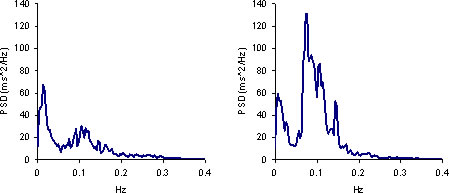
Group mean HRV power spectra calculated from 10-minute ECGs recorded before subjects completed the battery of cognitive performance tasks. The left-hand graph shows the mean HRV power spectrum before subjects were trained in the HeartMath coherence-building techniques, while the right-hand graph shows the mean power spectrum after they learned and practiced the techniques for seven weeks. Note the increase in power around the 0.1 Hz frequency range, indicating a pronounced increase in heart rhythm coherence. This shift is particularly notable because subjects were not specifically instructed to use the techniques during the post-recording.
The results of the pre- and post-analysis of the cognitive performance tests showed a significant improvement (p = 0.0049) in the quality of episodic (long-term) memory and a marginally significant improvement (p = 0.078) in the quality of working (short-term) memory (Figure 13).
Analysis of the questionnaire data also showed the participants reported feeling significantly calmer at the end of the study than they did at the beginning (t-test 2.44, p < 0.05).
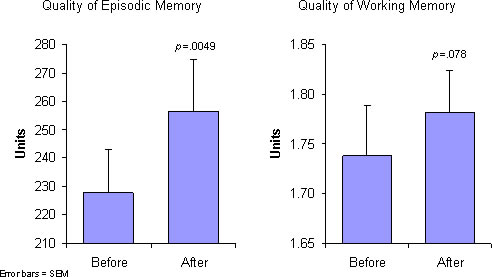
Mean improvements in quality of episodic (long-term) memory and quality of working (short-term) memory after practicing the HeartMath coherence-building tools for a seven-week period.
The finding of the observed gain of 12.6% in the quality of long-term memory over the seven week period during which coherence-building techniques were practiced is notable in that Dr. Wesnes reports the magnitude of improvement was noticeably higher than the improvement in quality of memory obtained in a large clinical 14-week trial of the effects of a pharmaceutical memory enhancer (a gingko/ginseng combination) on the memory of healthy volunteers.
To explain the observed pre-post changes in the quality of episodic memory and in self-rated calmness, two stepwise multiple regressions were run. Of the 10 independent variables included in each analysis, improvement in coherence was the only variable with sufficient statistical power to meet the criteria for entry into the stepwise analysis (p of F to enter = 0.05; p of F to remove = 0.10). The results show that the change in coherence is quite strongly related to the observed changes in episodic memory and calmness: it accounts for 21% of the variance in the improvement in long-term memory (F = 5.4, p < 0.05; adj. R² = 0.21), and it accounts for 42% of the variance in the reported increase in calmness (F = 13.18, p < 0.01; adj. R² = 0.42).
In his review of the study’s results, Dr. Wesnes concluded that learning and practicing the coherence-building techniques appeared to enhance an individual’s memory capacity and improve self-reported calmness.
Improved Workplace Performance
Most organizations accept that continual change has become the norm in a global economy and the resulting stresses and pressures are having major impacts on business performance and employee health.
Numerous scientific studies have shown these workplace pressures negatively impact the psychological and physiological processes of employees at all levels of organizations. This undermines performance, reduces perceptual clarity and directly impairs personal performance. Studies conducted at Shell, BP, Unilever, Cisco Systems Inc., The Boeing Company and many other firms have shown introduction of the HeartMath program and coherence training into the workplace leads to improvements in personal and business performance, reduced staff turnover, improved employee health, customer satisfaction and organizational effectiveness. Following are a few examples. More details and additional studies can be found at: https://www.heartmath.org/research/research-library/research-library.html
Reductions in Measures of Stress, Anxiety and Burnout
The primary measure used to assess employees’ stress and key indicators of organizational quality before and after employees attend HeartMath programs and use the emWave coherence-building technologies is the Personal and Organizational Quality Assessment-Revised (POQA-R). The POQA-R instrument captures self-reported changes in 24 categories of personal and organizational quality.
The figure below shows the combined data from 1,400 employees at two global oil companies. The figure shows the data from the assessment before they learned the HeartMath tools and used the emWave technologies, and the data six weeks and six months later.
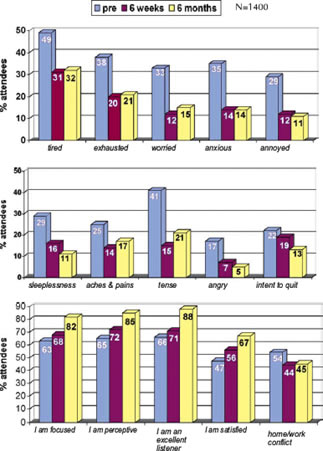
Reductions in Employee Blood Pressure
High blood pressure affects one in four adults in North America and Western Europe and is considered one of the most important public health issues facing the industrialized world. The HeartMath program has been shown consistently to reduce blood pressure. (Also see Health and Well-Being section). The size of this reduction has been measured at double the improvement an exercise program normally delivers, and if it were repeated across the entire population it could reduce the incidence of stroke by approximately 50%. The figure below shows the blood-pressure data from 78 individuals in three global companies before and three months after learning the HeartMath tools and using the emWave system.
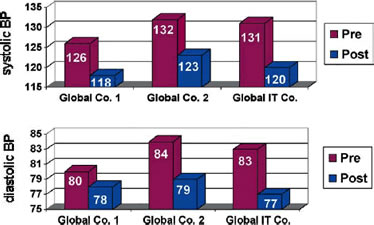
Increasing Heart Rate Variability (HRV)
As discussed in the science overview section heart-rate variability is considered an index of overall health status and well-being. Lowered HRV has repeatedly been shown to be associated with stress and is a powerful predictor of disease and all-cause mortality.
The figure below shows the average changes in HRV from 59 high-level executives at global companies over an eight-week period. The HRV data was collected over a 24-hour period from a group who learned and used HeartMath tools and emWave system, and a group who did not. The SDNN is a measure that reflects the overall amount of HRV one has over a 24-hour period. As can be seen in the graph, the executives who used the tools and emWave PC had a 13% increase in their HRV, while the other group’s overall HRV was reduced by 16%.
The increases in HRV in the group who used the tools reflect not only a reduction in health risk, but also increased energy and vitality.
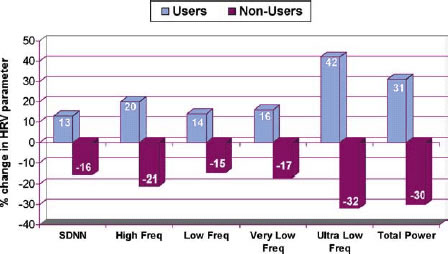
Health and Performance Improve at Large Government Agency
This research study examined the effect of a HeartMath training and coherence-building program on 54 employees in the Information Technology Services Division of a state agency that was experiencing change-related turmoil. The stress generated by these changes, combined with simultaneous changes in the division’s leadership created an emotional atmosphere of fragmentation, misperception and miscommunication in the work environment. Many employees reportedly were experiencing anger, anxiety and resentment. This combination of stress and negative effect was likened to an “emotional virus,” compromising the ability of the division to gracefully accept the changes and adapt to the new leadership style and technological direction.
Measures of personal and organizational quality (POQA) in the trained employees were compared to those of a 64-member comparison group who had not received the training. After completion of the training, seven weeks from the initial assessment, the study group demonstrated significant reductions in measures of stress and negative emotion and significant increases in measures of positive emotion and organizational effectiveness compared to the untrained group. There were significant decreases in anger, 20%; distress, 21%; depression, 26%; sadness, 22%; and fatigue, 24%. There were significant increases in peacefulness, 23% and vitality, 10%. There was also a reduction in stress symptoms, including anxiety, 21%; sleeplessness, 24%; and rapid heartbeats, 19%. Organizational quality assessment revealed significant gains in goal clarity, 9%, and productivity, 4%. These changes were noteworthy in light of the major organizational and emotional challenges faced by the participants and the relatively short time in which the improvements took place.
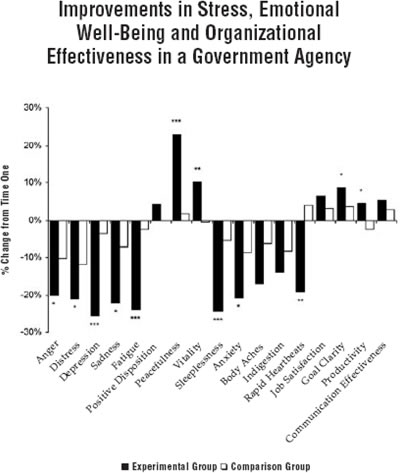
Results suggest that by facilitating increased self-management of participants’ mental and emotional turmoil, the HeartMath interventions enhanced employees’ capacity to defuse personal and organizational stress. The division’s qualitative reports to the researchers indicated these improvements were sustained over time and enabled a more efficient and harmonious change implementation process.
Increasing Nurse Retention and Patient Satisfaction in Hospitals
The emWave technologies and HeartMath system are being used by Duke Medical Center, Stanford University Medical Center, Kaiser Permanente, the University of North Carolina, Cleveland Clinic and many other top medical centers to reduce stress, fatigue, sleep problems and improve emotional fitness. This section proves several examples of how the HeartMath programs and emWave coherence-building technology have positively impacted key organizational measures and staff retention.
In the fall of 1999, the leadership team of Delnor-Community Hospital in Geneva, IL. identified three major objectives and a desire to achieve additional benefits if possible:
- Reduce turnover, vacancy and costs
- Become a national leader in patient satisfaction
- Be the hospital of choice in their primary market
Delnor employed the HeartMath program and supportive tactics in service excellence to achieve these goals.
First-Year Results
Turnover declines
- From 26.9% to 5.9% for the 422 HeartMath-trained staff and 26.9% to 21% for overall staff.
- $800,000 annualized savings.
Patient satisfaction improves
- From 73rd percentile nationwide to the 93rd percentile.
Additional Benefit
- Large jump in employee satisfaction – Ranked No. 1 nationwide – Sperduto & Associates national database.
Second-Year Results
Turnover rate continues to drop
- From 5.9% to 1.3% for HeartMath-trained staff and 21% to 14.5% overall.
Patient Satisfaction continues improvement
- Remains over 90%.
Additional Benefit
- Ranked No. 2 nationwide in employee satisfaction.
Third-Year Results
Turnover rate still falling
- 4% among HeartMath-trained employees, 14.4% for overall staff of 1,600.
Patient satisfaction improves
- Increases to 98%.
Additional Benefit
- Ranked No. 1 nationwide in employee satisfaction.
Summary of Outcomes
- Reduced staff turnover
- Reduced costs
- Increased patient satisfaction scores
- Improved employee satisfaction
- Won 2002 Corporate Health and Productivity Management Award from The Institute of Health and Productivity Management
- Received magnet hospital designation in 2004
Similar results have been obtained in other large hospitals:
Swedish Medical Center, Englewood, Colo. (HCA hospital)
Turnover Rates after first 600 staff trained in HeartMath tools
- 22% turnover rate for overall employees.
- 9% turnover rate for HeartMath-trained employees.
Return on Investment
- Turnover reduced by 13% for HeartMath-trained staff.
- 78 jobs saved (13% of 600 HeartMath-trained staff).
Sierra Providence Health Network, El Paso, Texas (Part of the Tenet Health System)
Turnover Rate Reductions Achieved:
- From 21% to 17% and 21% to 19% overall at two acute-care hospitals.
- From 21% to 5% for 282 HeartMath-trained staff.
- From 21% to 3% for 107 HeartMath-trained nurses.
Return on Investment:
- Turnover reduced by 16% for HeartMath-trained staff.
- = 45 jobs saved – 16% of 282 HeartMath-trained staff.
- = $2,160,000 annualized savings
- Turnover rate reduced by 18% for HeartMath-trained nurses.
- = 19 jobs saved – 18% of 107 HeartMath-trained nurses.
- = $912,000 annualized savings
HeartMath and emWave System in Law Enforcement
Police officers often are exposed to stress beyond the range of usual human experience. Without effective management, the acute and chronic stressors inherent in police work impose a significant burden on physical and psychological health and may lead to adverse physiological, emotional and behavioral outcomes. Officers operating under severe and chronic stress are at greater risk of error, accidents and overreaction that can compromise performance, jeopardize public safety and pose significant liability costs to the organization. Police officers are more than twice as likely to develop cardiovascular disease as workers in other occupations. Furthermore, family relationships among law enforcement officers often are severely impacted by job-related stresses.
This study, sponsored by seven police chiefs and conducted in conjunction with Sunnyvale Public Safety in Sunnyvale, a community in Santa Clara County, California, explored the impact of HeartMath interventions on the health and functioning of a group of police officers from seven county agencies. The HeartMath program, including use of emWave PC systems and tailored to address the stressors faced by the law enforcement profession, was provided to an intervention group of 29 officers. A waiting control group of 36 officers served as the control group.
The study was conducted over 16 weeks. Participants were assessed before and after the program in the following areas: physical symptoms and vitality; emotional well-being; coping and interpersonal skills; work performance; workplace effectiveness and climate; family relationships; and physiological and psychological recalibration following acute stress. Portable monitoring was used to obtain continuous ECG data throughout a series of very realistic simulated police calls used in police training – a building search, high-speed car chase and domestic-violence scenario – to determine the cardiovascular impact of acutely stressful situations typically encountered on the job. Scenarios were conducted before and after completion of the HeartMath program. Blood pressure recordings also were obtained before and after the scenarios.
Results indicated the HeartMath training improved officers’ capacity to recognize and manage stress and negative emotions in both work and personal contexts. Over the course of the study, officers trained in the HeartMath program experienced reductions in stress, negative emotions, fatigue and physical symptoms of stress, as well as increases in positive emotions, peacefulness and physical vitality. In contrast, officers in the control group showed minimal positive changes and some indications of worsening symptoms over the same time period. Notably, feelings of depression rose 17% among the untrained officers, while the HeartMath-trained group demonstrated a 13% drop in depression during the period. Similarly, fatigue declined among HeartMath group members by 18% and distress by 20%, whereas the control group demonstrated only a 1% reduction in each of these symptoms. Enhanced work performance in the trained group also was noted, as well as improvements in strained family relationships and communication difficulties at work – two principal and well-recognized sources of stress in the policing profession.
Heart-rate and blood-pressure measurements taken during the simulated police calls – acutely stressful circumstances similar to those encountered by officers on the job – demonstrated a tremendous degree of physiological activation, with heart rates rising 40 to 55 beats per minute above baseline, and, on average, taking over one hour to re-stabilize to baseline levels. In several cases, systolic blood pressure rose to over 200 mm Hg during the simulations, reflecting increases in the range of 80 to 120 mm Hg above starting values. Activation such as this requires considerable time for the body to readjust to baseline levels. However, according to their responses in semi-structured interviews, the majority of participating officers felt that application of the HeartMath interventions increased their calmness, clarity and focus during the scenarios and facilitated a more rapid and fuller recovery, both physiologically and psychologically, following the acute stress.
Autonomic nervous-system assessment based on HRV analysis revealed that 11% of the police officers tested were at high risk for cardiovascular disease and premature mortality, more than twice the ratio of at-risk individuals expected to be found in the general population. These findings underscore the importance and potential long-term health implications of providing effective self management interventions to individuals in high-stress professions such as law enforcement. The integration of such interventions in police training may enable officers to perform their jobs with greater effectiveness, to preserve and enhance their physical and emotional health, and ultimately to provide better protection to the citizens they serve.
Stress and Health Risk Reduction in Correctional Officers
This study investigated the impact of HeartMath’s Power to Change Performance stress and health risk reduction program and emWave system practice on physiological and psychological stress and health risk factors in a sample of correctional officers. Eighty-eight officers from three facilities were randomly assigned to an experimental group and a wait-list control group. The program included instruction on health risk factors as well as training in positive emotion-focused stress-reduction techniques intended to reduce negative emotional arousal, improve physiological balance, increase positive effect and enhance performance. Learning and practice of the techniques was enhanced by heart-rate-variability feedback, which helped participants learn to self-generate physiological coherence, a beneficial mode associated with increased efficiency and synchronization in the functioning of physiological systems. Measures of physiological and psychological stress and health risk were assessed before the program and again three months after it concluded. The measures included in the health risk assessment were the Personal Wellness Profile self-report survey, which assesses a broad range of health-related information, behaviors and attitudes and the following four biometric markers: height, weight, blood pressure and total cholesterol levels. Additional measures reflective of physiological stress and overall health included cortisol and DHEA, secretory immunoglobulin A – an immune-system marker – HDL and LDL cholesterol, triglycerides, fasting glucose levels, a 10- minute resting electrocardiogram and measures of heart-rate variability – an indicator of autonomic function. Three self-report psychological surveys also were included to assess emotional stress and work-related variables.
An analysis of baseline data revealed that officers in this study were under greater stress and at greater health risk compared to a reference sample of working adults. A pre-post analysis showed that three months after the intervention program, employees in the experimental group demonstrated significant reductions in stress and health risk factors, as well as significant improvements in work-related parameters. Physiological changes in the experimental group included significant reductions in total cholesterol, LDL cholesterol levels, the total cholesterol/HDL ratio, fasting glucose levels, mean heart rate, and systolic and diastolic blood pressure.


Psychological changes included significant reductions in overall psychological distress, anger, fatigue, hostility, global Type A behavior, speed and impatience, interpersonal sensitivity and increases in gratitude and positive outlook. There were also improvements in key organizationally relevant measures in the experimental group after the program, including significant increases in productivity, motivation, goal clarity and perceived manager support. Finally, the reduction in health risk factors achieved in this study are projected to lead to reductions in both healthcare and absentee costs, yielding a total projected annual cost savings of $699 per employee.
In conclusion, the results of this study indicate the Power to Change Performance program was effective in significantly reducing stress and health risk factors in a population of correctional officers, while enhancing employee productivity and psychological well-being. These changes were realized with minimal intervention and in a relatively brief period of time and should result in significant cost savings to the organization if the program is expanded to larger employee populations. Thus, by reducing the physiological, psychological, performance-related and financial impact of high stress and health risks in the crucial and demanding profession of corrections work, this program promises significant benefits both to the employees as individuals and to the organization as a whole.
Related Links:
HeartMath Corporate Wellness Programs: HeartMath.com/Corporate
Corporate: Resources
HeartMath® has many products and services to enhance your learning process. Follow the links below to obtain additional resources.
“HeartMath has its roots in science. It has a hard core to it.”
—John Quinlivan, Vice President, 747 & 767 Airplane Programs, Boeing
Free Orientation Call
Every week a HeartMath emWave® specialist conducts a phone session on how to use the emWave Systems and to answer your questions. To find the schedule for these calls, Click Here.
emWave®
emWave can greatly improve your work performance, quickly and easily. Use it whenever you feel stress coming on. Just refocus, recoup, and be better. The emWave system includes a simple and easy to use hand–held device as well as a desktop software program. You will feel more self-composed, think more clearly, be more patient, and perform more confidently — all of which help to enhance mental acuity and productivity, to get you operating at peak performance in a heartbeat. Even your work relationships can improve. To find out more, Click Here.
The Resilience Advantage for Leaders
A Personal Toolkit to Maximize Energy, Influence and Clarity
Leading organizations has never been so challenging and requires a new kind of awareness and resilience.
Refine your skills at leading others includes developing compassion and inspiration. Click Here.
Organizational Training Programs
HeartMath provides a suite of scientifically validated training programs that:
- increase productivity and performance
- improve employee health and satisfaction
- increase employee engagement
- improve customer loyalty
- reduce turnover
- decrease health care utilization
Additionally, you can learn about our Staff Retention and Development Program designed for practical use in today’s fast paced health care environment.
For more information, Click Here.
emTech™ Media Products
The emTech products were created from a variety of HeartMath resources. These products offer some of the best subject-specific information found in the HeartMath System, giving you easy access to what interests you most.
The emTech e-booklets, audio programs and interactive learning modules are delivered electronically so you can get the information you need quickly and inexpensively. Simply download what you want and receive it right away. Click Here.
From Chaos to Coherence: The Power to Change Performance, by Doc Childre and Bruce Cryer
This book is essential for developing people and powerful organizations that respond gracefully to change, crisis and challenge. Well-documented examples, biomedical research and organizational case studies show how to become more effective and reduce stress. Called the “Microsoft of emotional coherence” on Amazon.com. Quick tips, broadly applicable insights, and great stories about real successes. This item is available only as an e–book. Click Here.
Transforming Stress: The HeartMath Solution for Relieving Worry, Fatigue, and Tension, by Doc Childre and Deborah Rozman, Ph.D.
This book teaches readers to use the HeartMath method to reduce stress. It teaches them how to engage their hearts to bring emotion, body, and mind into balance, and helps them stay in a zone of focused clarity, optimal health, and high performance. Click Here.
Transforming Anger: The HeartMath Solution for Letting Go of Rage, Frustration and Irritation, by Doc Childre and Deborah Rozman, Ph.D.
If you are dealing with anger that is difficult to manage, this book can give you hope, as well as practical tools to successfully handle this emotion. This book will help you to better understand:
- how and why anger occurs in your daily life
- how your body triggers anger
- why your body responds to anger
Additionally you will learn to use fast-acting tools and techniques to get in sync and release anger. Click Here.
Transforming Anxiety: The HeartMath Solution for Overcoming Fear and Worry and Creating Serenity, by Doc Childre and Deborah Rozman, Ph.D.
Nothing can destroy health and quality of life faster than chronic anxiety, that vague feeling of unease and distress that something, somehow is hopelessly wrong. Unfortunately, problems as a result of anxiety are steadily on the rise. Anxiety disorders have always been the most common of psychological problems. In fact, new reports suggest that nearly 25 percent of Americans at any given time suffer from some form of anxiety. In response to this growing problem, the scientists at the HeartMath Institute have adapted their revolutionary techniques into a fast and simple program that anyone can use to break free from anxiety once and for all.
It shows you how to engage your heart to bring emotion, body, and mind into balance, and helps you stay in a zone of focused clarity, optimal health, and high performance. Changes brought about through this method are fast-acting and long-lasting — the perfect antidote to our chaotic and anxiety-provoking lives. Click Here.
Transforming Depression: The HeartMath® Solution to Feeling Overwhelmed, Sad, and Stressed, by Doc Childre and Deborah Rozman, Ph.D. Foreword by Frank Lawlis, Ph.D., Clinical and Counseling Psychologist
Could your life be any crazier and more overwhelming? You’re bombarded all day, every day by deadlines, demands, and news, much of it bad, from across the street and around the world. After awhile, this constant sense of being overwhelmed, fatigued, and stretched to the limit can leave you feeling hopeless and uninterested in things that you used to enjoy. In other words, you have become depressed. By using the HeartMath techniques in this book, you’ll learn how to tap into new resources of energy and creativity and find new ways to connect with the people in your life. In no time, your feelings of depression will lessen and dramatic changes will take place in your mind and body that will result in better health and greater peace of mind. Click Here.
The HeartMath Approach to Managing Hypertension: The Proven, Natural Way to Lower Your Blood Pressure, by Bruce C. Wilson, MD and Doc Childre
High blood pressure is a national epidemic. It’s a condition that affects one in four Americans, most of whom have no idea they are at high risk for heart disease, stroke, and other life threatening conditions. The conventional treatment for hypertension is prescription drugs, most can have serious side effects and may not ultimately succeed in reducing your blood pressure. Fortunately, the HeartMath Institute has researched techniques for managing stress and hypertension for more than fifteen years. Now, at last, these highly effective strategies for regulating blood pressure safely and effectively are available to you.
The HeartMath Program described in this book offers a unique opportunity in the arena of stress management. Recognizing a stressful situation and taking a quick timeout to begin a simple HeartMath technique to shift your emotional attitude has a profound effect on the nervous system. It changes your physiology from a “fight-or-flight” stimulated state to one of calm and clarity. The simple end result is a decrease in stress hormone production with a resultant decrease in blood pressure and heart rate. Click Here.